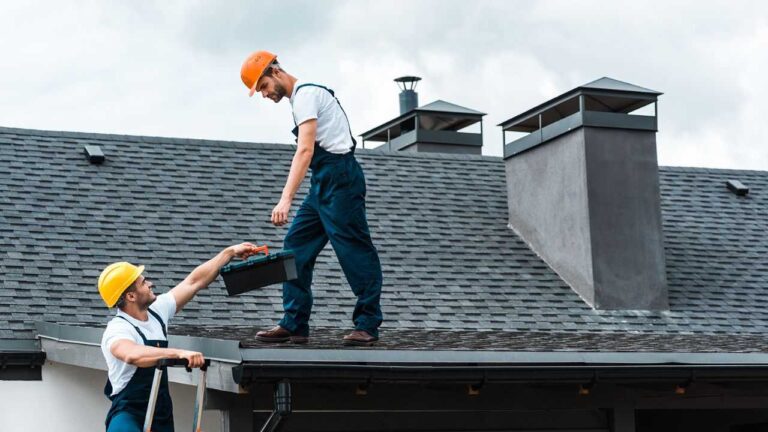So your roof just took a beating from Mother Nature, and you’re standing there wondering what to do next. Been there!
Roof problems rank among the most stressful home issues because, let’s face it, that’s literally the thing keeping rain off your head.
When storms roll through, your roof is your first line of defense.
But how do you know when damage has happened? And what should you do about insurance? These aren’t questions you want to figure out while water’s dripping onto your favorite couch.
I’ve put together nine straightforward ways to check your roof and handle insurance without getting a headache.
Think of this as your no-panic guide to roof problems. Ready? Let’s get started.
9 Ways To Assess Roof Damage And Insurance Options
Figuring out roof damage isn’t rocket science, but it does take some know-how. These nine steps will walk you through checking for problems and dealing with insurance without missing anything important.
Visual Inspection from the Ground
Look up! Seriously, grab some binoculars and walk around your house. You’d be surprised what you can spot from the ground.
What you’re looking for: missing shingles, curled edges, dark spots, or anything that just looks “off.” If your roof has sections that look different from the rest, that’s a clue something’s wrong.
After a storm, this quick check can tell you if you need to call a pro right away.
I always tell homeowners to do this check every few months anyway, not just after storms. Catching problems early saves major headaches later.
Safety first though! Don’t climb up there yourself unless you really know what you’re doing. Binoculars work just fine for this first look.
Check for Water Leaks and Stains Inside the Home
Your ceiling tells stories about your roof. Water stains, peeling paint, or damp spots are like your house whispering, “Hey, there’s a problem up there!”
Walk through each room and look up. Pay special attention to corners, areas around chimneys, and spots near skylights. These tend to leak first. Touch any suspicious areas—dampness is a dead giveaway.
Roof damage after heavy rain often shows up as yellow or brown rings on ceilings. If you spot these, take photos right away for insurance purposes. Date them too!
Remember to check your walls as well. Water sometimes travels down rafters before dripping, causing damage far from the actual roof leak.
Inspect the Attic and Insulation
Your attic is like the backstage area where roof problems first appear. Grab a flashlight and head up there on a sunny day.
Turn off the lights and look up. See any tiny pinpoints of light coming through the roof? Those are holes! While you’re up there, check for:
- Wet or discolored insulation
- Damp wood or rafters
- Musty smells (hello, mold!)
- Water stains on the underside of the roof
Feel the insulation with your hand. It should be dry and fluffy. If it’s compacted or wet, that’s a problem.
This check works best after rain when leaks are most obvious. And remember—water follows the path of least resistance, so the damage might not be directly under where you see a leak inside your living space.
Examine Flashing and Sealants
Think of flashing as your roof’s waterproof seams. These metal pieces cover the gaps around chimneys, vents, skylights, and roof valleys.
Walk around and check if any flashing looks:
- Bent or pulled away
- Rusty or corroded
- Missing pieces
- Cracked sealant around the edges
The rubber boots around pipes often crack first. If they look brittle or have gaps, they need replacing before the next storm hits.
Sealants don’t last forever—they typically need replacing every 5-7 years. If yours look cracked or peeling, add that to your repair list.
Look for Granule Loss in Gutters
Your gutters collect evidence. Those tiny granules that cover asphalt shingles protect them from sun damage. When they wash off, your roof ages faster.
After a storm, grab a ladder and check your gutters and downspouts. A few granules are normal, but piles of them suggest your shingles are deteriorating.
The granules look like coarse, dark sand. If you see lots after roof cleaning your gutters or after heavy rain, take photos. This is solid evidence for insurance claims.
New roofs naturally shed some excess granules, but older roofs losing granules means they’re near the end of their life. Know which situation you’re dealing with before calling insurance.
Assess Storm and Hail Damage
Hail leaves fingerprints. After a hailstorm, look for:
- Round dents in metal vents or flashing
- Spots where granules are missing, creating dark “bruises” on shingles
- Cracks or splits in shingles
- Shiny spots where hail knocked off the protective coating
Wind damage has its own signs:
- Shingles lifting at the edges
- Entire missing patches
- Debris stuck under shingles
The tricky thing about storm damage is timing. Most insurance policies require you to report damage within a specific window (usually 30-60 days), so don’t wait to check after storms.
Take dated photos or videos right after the storm passes. Weather reports for your zip code can back up your claim too.
Evaluate Roof Age and Material Condition
How old is your roof? This question matters hugely for insurance.
Most asphalt shingle roofs last 20-25 years. Metal might go 50+ years. If you’re not sure, check your home records or ask a roofer to estimate the age.
Older roofs show signs like:
- Curling shingle edges
- Bald spots where granules are gone
- Cracked or brittle shingles
- A roof that looks “tired” overall
Insurance companies know these lifespans too. They might deny claims for normal wear and tear on an old roof, while approving the exact same damage on a newer one.
If your roof is nearing the end of its expected life, be extra diligent about maintenance and document everything.
This helps distinguish between age-related issues and actual damage events.
Document Roof Damage with Photos and Notes
Your phone is your friend here. Take clear photos of every bit of damage you find. Include:
- Wide shots showing the overall roof
- Close-ups of damaged areas
- Inside shots of leaks or water stains
- Shots of debris or tree branches if they caused damage
Write notes about when you first noticed the damage and what weather event might have caused it. Keep receipts for any emergency roof repairs you make.
Create a simple timeline document: when the storm hit, when you discovered the damage, who you contacted and when. This organization makes insurance claims way smoother.
Smart tip: take “before” photos of your roof when it’s in good condition. Having comparison shots is super helpful for claims.
Contact a Roofing Professional for an Inspection
DIY checks are great, but nothing beats a pro’s eye. Professional roofers know exactly what to look for and can spot problems you might miss.
When choosing a roofer for inspection:
- Look for someone who specializes in your roof type
- Check reviews and ask neighbors for recommendations
- Make sure they understand insurance claims if you’re heading that route
- Ask if they charge for inspections (many offer free ones)
A good inspector will give you a written report with photos, explaining exactly what they found. This document is gold for insurance claims.
Ask them to explain which damage is likely covered by insurance and what might be considered normal wear. This knowledge helps you decide whether filing a claim makes sense.
Conclusion
Roof problems never come at convenient times, but knowing how to check for damage puts you miles ahead. The sooner you spot issues, the less they’ll cost to fix.
Remember these key takeaways: check your roof regularly (not just after storms), document everything with photos, know your roof’s age and expected lifespan, and don’t hesitate to call in pros when needed.
And about insurance—they’re more likely to approve claims when you have solid documentation and act quickly.
Not every roof problem warrants an insurance claim, but when major damage hits, being prepared makes all the difference.
Your roof protects everything else in your home. Return the favor by keeping a watchful eye on it!



